Vulcanization Characteristics and Static/Dynamic Mechanical Properties of Chlorinated Butyl Rubber Matrix Materials
Abstract
:1. Introduction
2. Materials and Methods
2.1. Materials
2.2. Experimental Formula
2.3. Blends Preparation
2.4. Characterization Methods
- (1)
- Frequency selection: To cover a broad frequency range, four frequencies (1 Hz, 10 Hz, 39.8 Hz, and 100 Hz) were selected.
- (2)
- ∆tanδ calculation: At the selected frequency, ∆tanδ between blends with different NR contents and NR0 were calculated.
- (3)
- Step (2) was repeated to obtain ∆tanδ at different frequencies.
- (4)
- ∆tanδ was fitted against NR content.
3. Results and Discussion
3.1. Vulcanization Characteristics of EPDM/CIIR Blends and NR/CIIR Blends
3.2. Quasi-Static Mechanical Properties of EPDM/CIIR Blends and NR/CIIR Blends
3.3. Dynamic Mechanical Properties of EPDM/CIIR Blends and NR/CIIR Blends
4. Conclusions
Author Contributions
Funding
Institutional Review Board Statement
Data Availability Statement
Conflicts of Interest
Abbreviations
| CIIR | Chlorinated butyl rubber |
| NR | Natural rubber |
| EPDM | Ethylene propylene diene monomer rubber |
| IIR | Butyl rubber |
| TAC | Triallyl cyanate |
| MMA | Methyl methacrylate |
| MES | EPDM-g-MMA St/MS resin blend |
| CCA | Citric acid |
| MAH | Maleic anhydride |
References
- Han, Y.; Zheng, H.; Liu, Y.; Wang, M.; Wang, J.; Xie, Q.; Jing, S.; Qin, X.; Zhang, L. Synergistic development of natural rubber/butyl rubber composites for improved interfacial bonding and enhanced shock-absorbing capabilities. ACS Omega 2024, 9, 13897–13905. [Google Scholar] [CrossRef] [PubMed]
- Chen, B.; Dai, J.; Song, T.; Guan, Q. Research and development of high-performance high-damping rubber materials for high-damping rubber isolation bearings: A review. Polymers 2022, 14, 2427. [Google Scholar] [CrossRef]
- Mikhaylov, I.A.; Sukhareva, K.V.; Andriasyan, Y.O.; Popov, A.A. Chlorinated rubbers with advanced properties for tire industry. AIP Conf. Proc. 2017, 1909, 020009. [Google Scholar]
- El-Sabbagh, S.H.; Ismail, M.N.; Mahmoud, D.S.; Yehia, A.A. Investigation of natural rubber compatibility with different types of butyl rubber. Egypt. J. Chem. 2023, 66, 309–321. [Google Scholar] [CrossRef]
- Roshan-Tabari, F.; Toopchi-Nezhad, H.; Hashemi-Motlagh, G. Development and testing of a novel high-damping chlorobutyl rubber for structural viscoelastic damper devices. Civ. Eng. Infrastruct. J. 2024, 57, 337–355. [Google Scholar]
- Shi, X.; Yuan, X.; Guo, X.; Zeng, F.; Liu, G. A new way to investigate the damping properties of NR/CIIR blends characterized by the rebound behaviors. Polym. Adv. Technol. 2022, 33, 3522–3531. [Google Scholar] [CrossRef]
- Tang, K.; Wang, J. Chlorinated butyl rubber/two-step modified montmorillonite nanocomposites: Mechanical and damping properties. Chin. J. Chem. Eng. 2022, 42, 437–449. [Google Scholar] [CrossRef]
- Sheng, Z.; Wang, J.; Yang, S.; Song, S. Novel polysiloxane microspheres: Preparation and application in chlorinated butyl rubber (CIIR) damping composites. Adv. Powder Technol. 2019, 30, 632–643. [Google Scholar]
- Sheng, Z.; Yang, S.; Wang, J.; Lu, Y.; Tang, K.; Song, S. Preparation and properties analysis of chlorinated butyl rubber (CIIR)/organic diatomite damping composites. Materials 2018, 11, 2172. [Google Scholar] [CrossRef]
- Hwang, Y.; Lee, W.; Park, C. Mechanical property, thermal conductivity, rebound resilience and thermal property of chloro isobutylene isoprene rubber/ethylene propylene diene monomer blend. Elastomers Compos. 2018, 53, 80–85. [Google Scholar]
- Payungwong, N.; Wu, J.; Sakdapipanich, J. Unlocking the potential of natural rubber: A review of rubber particle sizes and their impact on properties. Polymer 2024, 308, 127419. [Google Scholar] [CrossRef]
- Costa, N.L.; Hiranobe, C.T.; Cardim, H.P.; Dognani, G.; Sanchez, J.C.; Carvalho, J.A.; Torres, G.B.; Paim, L.L.; Pinto, L.F.; Cardim, G.P.; et al. A review of EPDM (ethylene propylene diene monomer) rubber-based nanocomposites: Properties and progress. Polymers 2024, 16, 1720. [Google Scholar] [CrossRef]
- Liu, Z.; Wang, K.; Wu, Y.; Zhang, H.; Hao, T.; Qi, H.; Liu, B. A novel method to characterize the damping capacity of EPDM/CIIR blends using vibrating rubber balls. Polymers 2024, 16, 1447. [Google Scholar] [CrossRef] [PubMed]
- Paul, P.; Joseph, R. EPDM/CIIR blends: Rheology, air permeability, thermal stability and thermal diffusivity. Int. J. Sci. 2014, 3, 1359–1370. [Google Scholar]
- Kidavu, A.V.; Ganash, D.; Maria, H.J.; Chaudhary, A.K.; Thomas, S. Study of surface roughness based opto-mechanical properties of chlorobutyl (CIIR)/natural rubber (NR) 70/30 filled with different contents of hybrid (CB/CN) using time domain terahertz spectroscopy. Polym. Bull. 2024, 81, 14183–14198. [Google Scholar] [CrossRef]
- Ma, P.; Hristova-Bogaerds, D.G.; Lemstra, P.J.; Zhang, Y.; Wang, S. Toughening of PHBV/PBS and PHB/PBS blends via in situ compatibilization using dicumyl peroxide as a free-radical grafting initiator. Macromol. Mater. Eng. 2012, 297, 402–410. [Google Scholar] [CrossRef]
- Abtahi, M.; Bakhshandeh, G.; Farahani, T. Effect of TAC (Triallyl cyanurate) on curing characteristics and mechanical properties of silica filled EPDM rubber. Polym.-Plast. Technol. Eng. 2006, 45, 183–189. [Google Scholar] [CrossRef]
- Fu, J. Toughening effect of EPDM-g-MS on MS resin. China Plast. 2007, 21, 3507–3515. [Google Scholar]
- Kim, J.; Bae, J.; Lee, J.; Lee, Y.; Kim, H. Preparation and properties of high-performance recyclable ethylene propylene diene rubber. J. Appl. Polym. Sci. 2015, 132, 42718–42727. [Google Scholar] [CrossRef]
- Botros, S.; Tawfic, M. Synthesis and characteristics of MAH-g-EPDM compatibilized EPDM/NBR rubber blends. J. Elastomers Plast. 2016, 38, 349–365. [Google Scholar] [CrossRef]
- Chen, K.; Ni, L.; Zhang, H.; Xie, J.; Yan, X.; Chen, S.; Qi, J.; Wang, C.; Sun, X.; Li, J. Veiled metal organic frameworks nanofillers for mixed matrix membranes with enhanced CO2/CH4 separation performance. Sep. Purif. Technol. 2021, 279, 119707. [Google Scholar] [CrossRef]
- Wang, N.; Li, Z.; Zhu, G.; Yu, Z.; Qin, R.; Zhou, J.; Lin, N. Chemical modifications on cellulose nanocrystals for composites: Surface chemistry to tailored compatibility and mechanical enhancement. Macromolecules 2023, 56, 7505–7519. [Google Scholar] [CrossRef]
- Zhu, P.; Feng, L.; Liu, J.; Wang, M.; Ma, N.; Tsai, F.-C.; Tang, Y. Influence of concentration, dispersibility, compatibility and orientation of rod-like cellulose nanocrystals in epoxy resin on the mechanical performance of their composite films. Prog. Org. Coat. 2024, 194, 108588. [Google Scholar] [CrossRef]
- Muthuraj, R.; Misra, M.; Mohanty, A. Biodegradable compatibilized polymer blends for packaging applications: A literature review. J. Appl. Polym. Sci. 2018, 135, 45726. [Google Scholar] [CrossRef]
- Dorogato, A.; Rigotti, D.; Fredi, G. Advanced industrial and engineering polymer research. Adv. Ind. Eng. Polym. Res. 2022, 5, 1–15. [Google Scholar]
- Nesterov, A.; Lipatov, Y. Compatibilizing effect of a filler in binary polymer mixtures. Polymer 1999, 40, 1347–1349. [Google Scholar] [CrossRef]
- Ginzburg, V.V. Influence of nanoparticles on miscibility of polymer blends. A simple theory. Macromolecules 2005, 38, 2362–2367. [Google Scholar] [CrossRef]
- George, J.; Thomas, S. The effect of polymeric inclusions and nanofillers on cure kinetics of epoxy resin: A review. Polym. Sci. Ser. A 2021, 63, 637–651. [Google Scholar]
- Taguet, A.; Cassagnau, P.; Lopez-Cuesta, J. Structuration, selective dispersion and compatibilizing effect of (nano) fillers in polymer blends. Prog. Polym. Sci. 2014, 39, 1526–1563. [Google Scholar] [CrossRef]
- Chu, Y.; Sun, Y.; Wu, W.; Xiao, H. Dispersion properties of nanocellulose: A review. Carbohydr. Polym. 2020, 250, 116892. [Google Scholar] [CrossRef]
- Sharma, B.; Malik, P.; Jain, P. Biopolymer reinforced nanocomposites: A comprehensive review. Mater. Today Commun. 2018, 16, 353–363. [Google Scholar] [CrossRef]
- GB/T 16584-1996; Rubber–Measurement of Vulcanization Characteristics with Rotorless Curemeters. China Standards Press: Beijing, China, 1996.
- GB/T 528-2009; Rubber, Vulcanized or Thermoplastic−Determination of Tensile Stress-Strain Properties. China Standards Press: Beijing, China, 2009.
- Joseph, A.M.; George, B.; Madhusoodanan, K.N.; Alex, R. Cure characteristics of devulcanized rubber: The issue of low scorch. Rubber Chem. Technol. 2017, 90, 536–549. [Google Scholar] [CrossRef]
- Ismail, H.; Che Mat, N.; Othman, N. Curing characteristics, tear, fatigue, and aging properties of bentonite-filled ethylene-propylene-diene (EPDM) rubber composites. J. Vinyl Addit. Technol. 2018, 24, E77–E84. [Google Scholar] [CrossRef]
- Li, L.; Choi, Y.J.; Boonkerd, K.; Zhang, J.; Gao, L.J.; Zhang, Z.X.; Kim, J.K. Prediction of the chlorobutyl rubber/natural rubber blend properties using a genetic algorithm and artificial neural network. Rubber Chem. Technol. 2013, 86, 190–204. [Google Scholar] [CrossRef]
- Deng, L.; Yin, D.; Xiang, W.; Sung, Q.; Ding, X.; Zhao, X. Co-vulcanization of eucommia ulmoides gum-styrene butadiene rubber composite system and its dynamic and static mechanical properties. Acta Mater. Compos. Sin. 2022, 39, 5892–5900. (In Chinese) [Google Scholar]
- Schaefer, R. Mechanical properties of rubber. In Harris’ Shock and Vibration Handbook, 6th ed.; McGraw-Hill: New York, NY, USA, 2010; pp. 33.1–33.18. [Google Scholar]
- Gabriel, P.; Thomas, A.; Busfield, J. Influence of interface geometry on rubber friction. Wear 2010, 268, 747–750. [Google Scholar] [CrossRef]
- Lu, X.; Li, X.; Tian, M. Preparation of high damping elastomer with broad temperature and frequency ranges based on ternary rubber blends. Polym. Adv. Technol. 2014, 25, 21–28. [Google Scholar] [CrossRef]

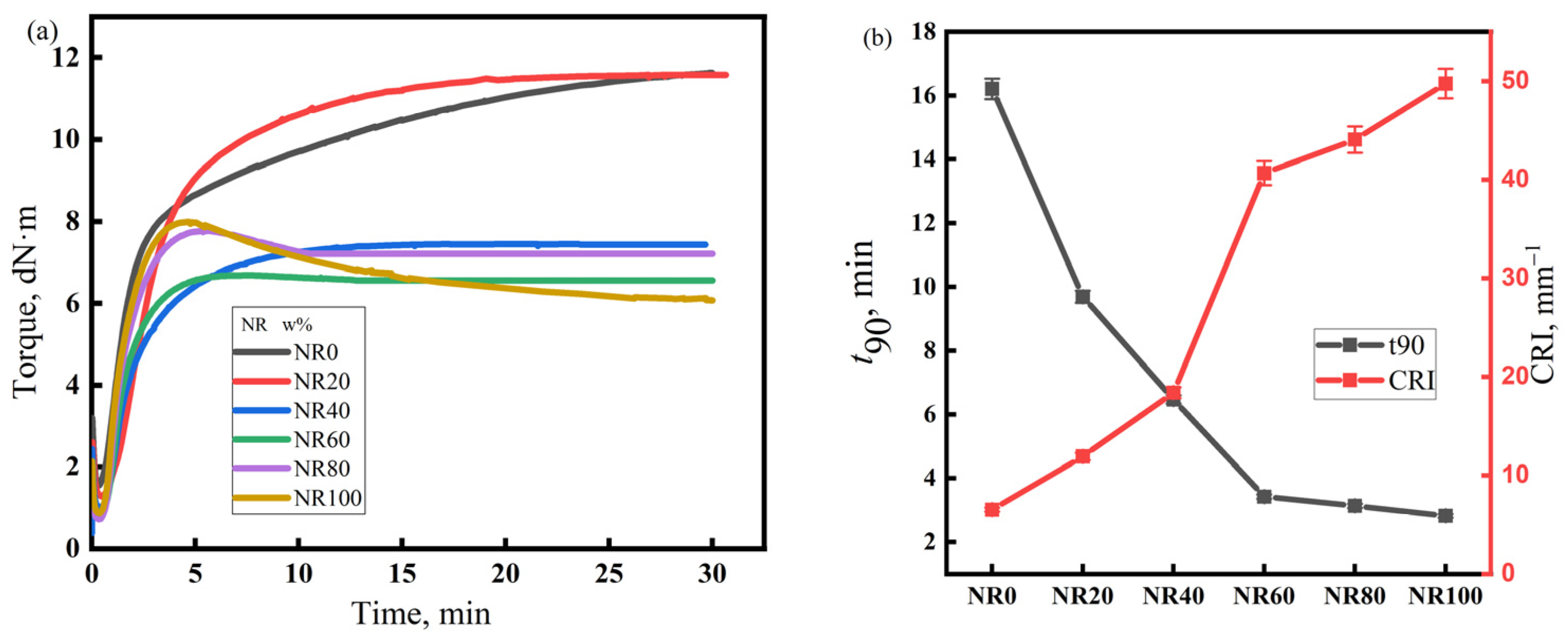
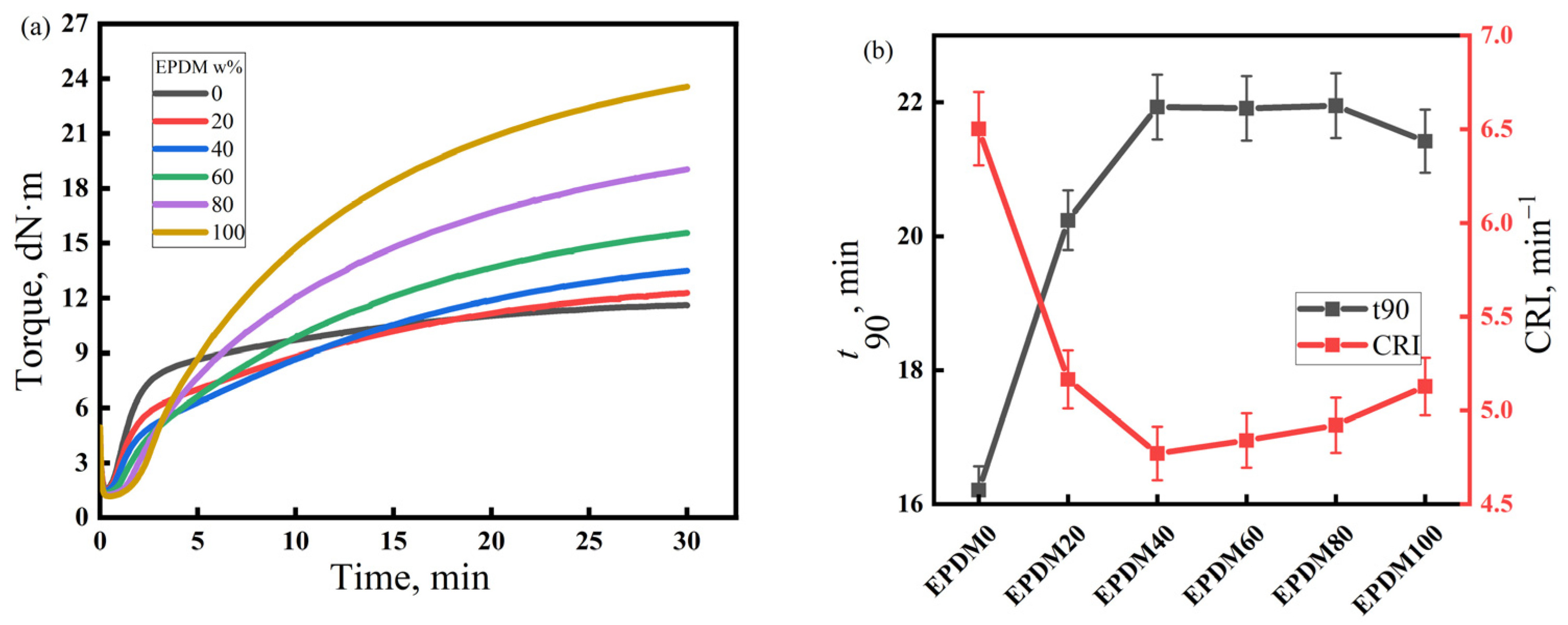

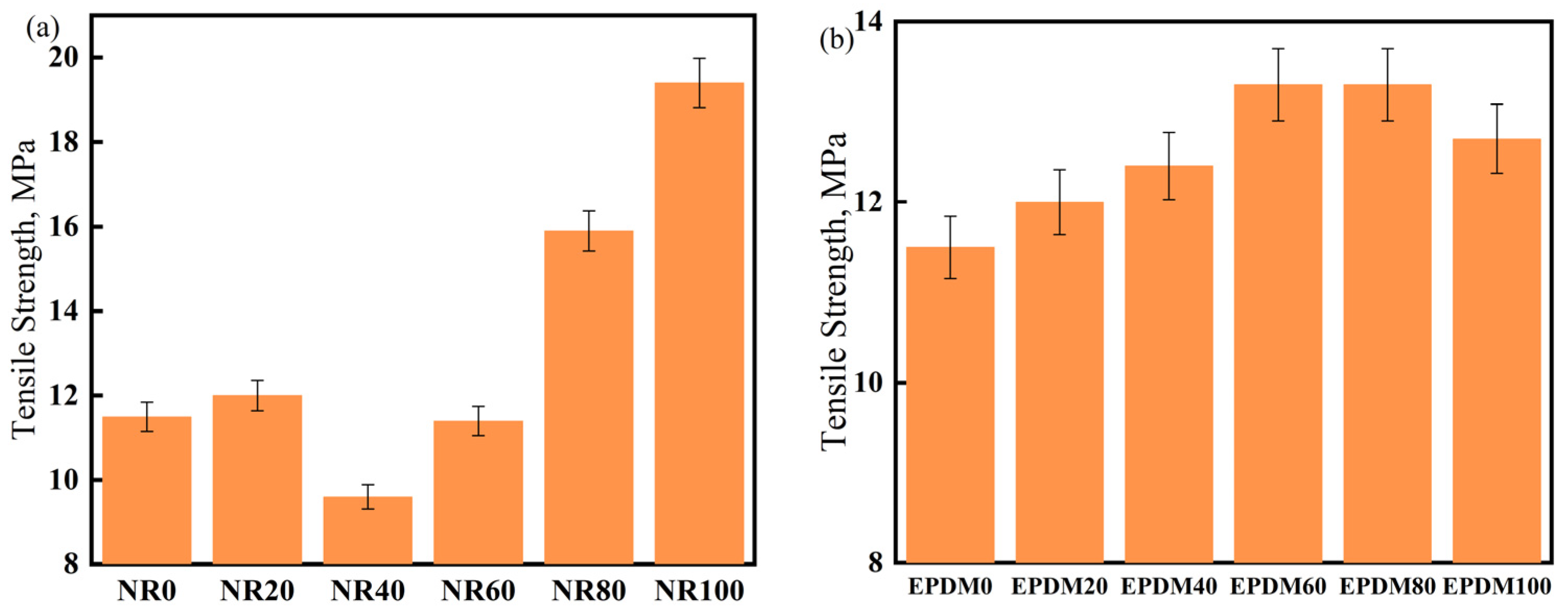
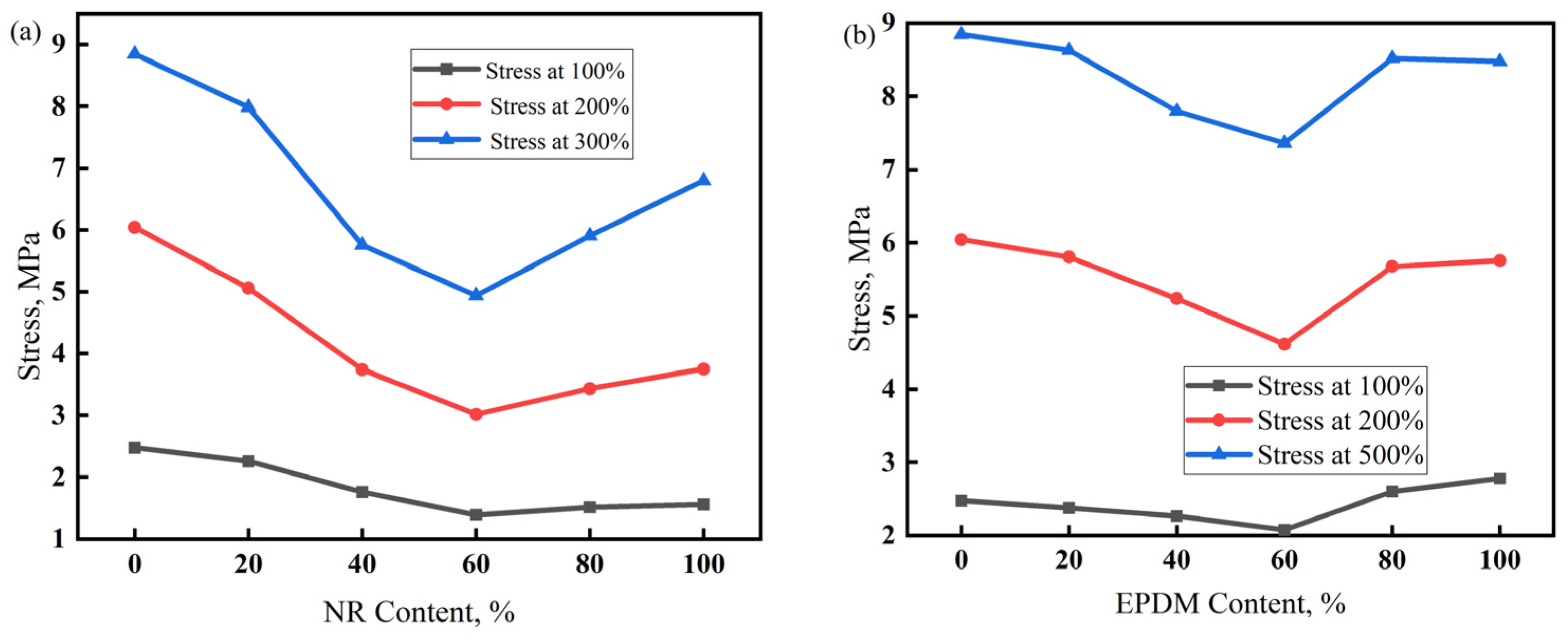

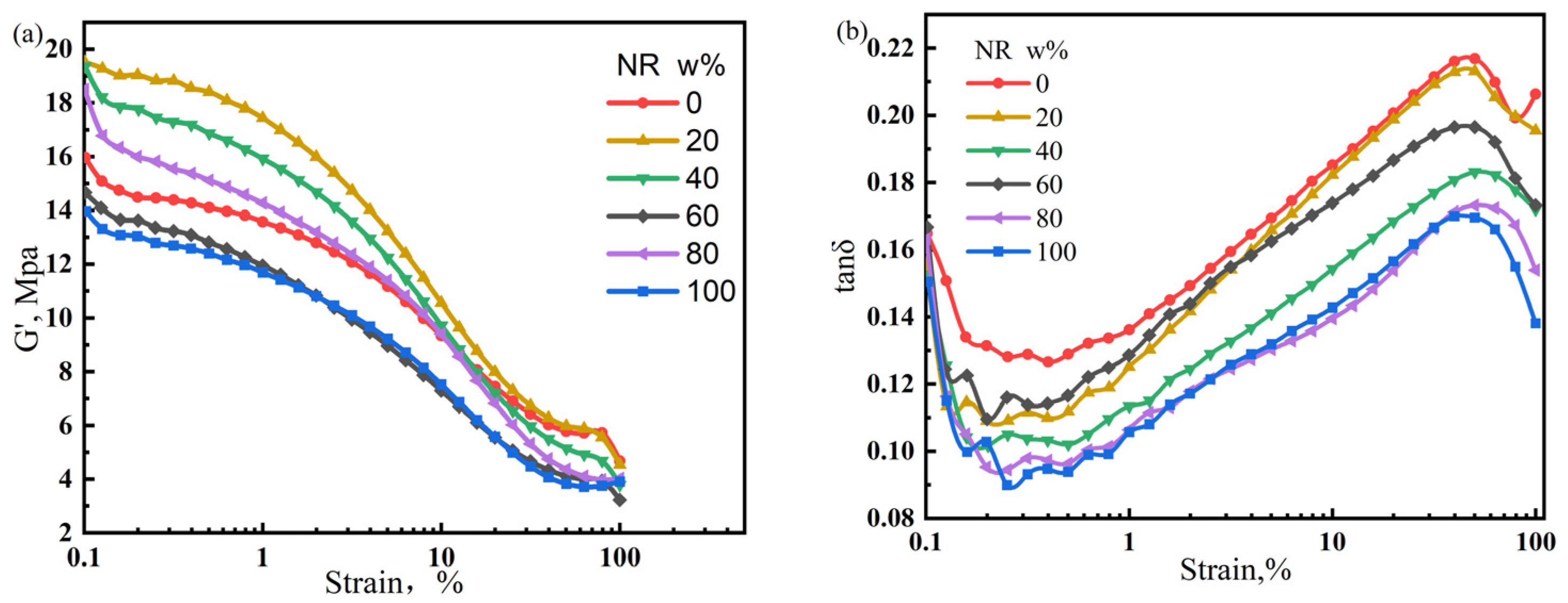
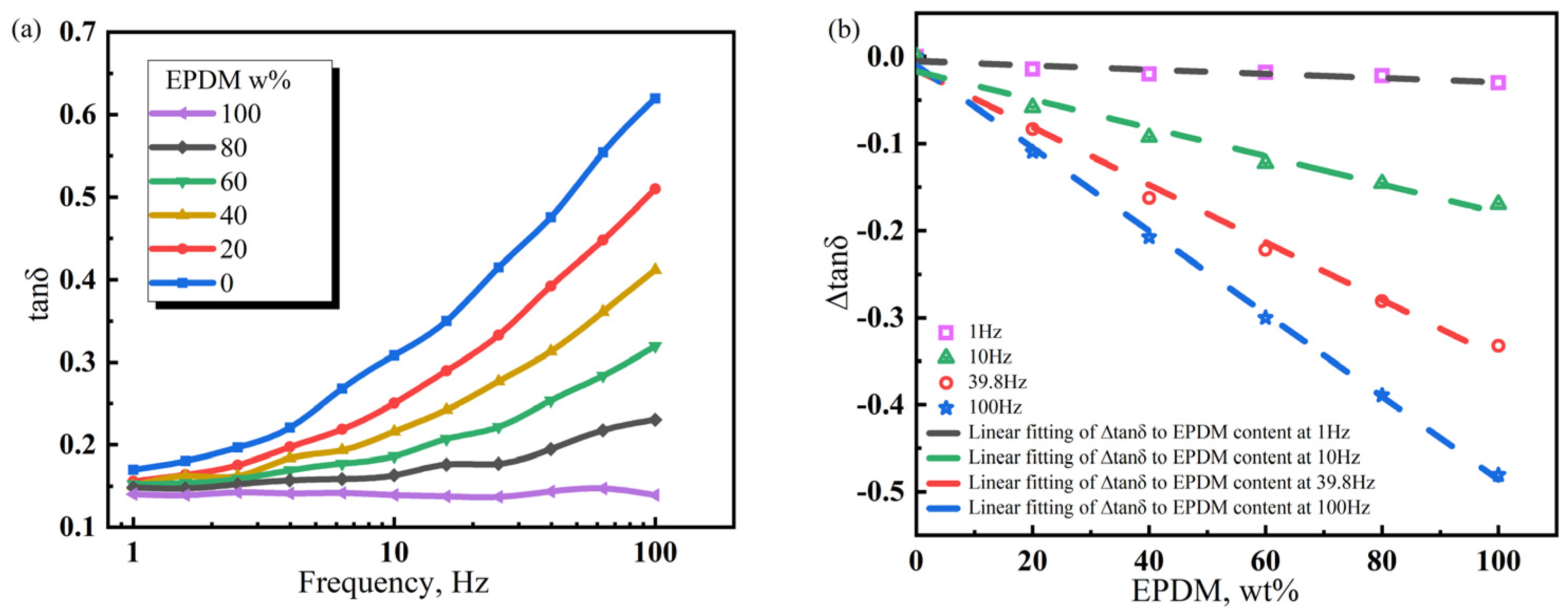

| Component (phr) | NR0 | NR20 | NR40 | NR60 | NR80 | NR100 |
|---|---|---|---|---|---|---|
| CIIR | 100 | 80 | 60 | 40 | 20 | |
| NR | 20 | 40 | 60 | 80 | 100 | |
| N550 | 50 | 50 | 50 | 50 | 50 | 50 |
| Paraffin oil | 5 | 5 | 5 | 5 | 5 | 5 |
| Zinc oxide | 5 | 5 | 5 | 5 | 5 | 5 |
| Stearic acid | 2 | 2 | 2 | 2 | 2 | 2 |
| 4020 | 1 | 1 | 1 | 1 | 1 | 1 |
| DM | 1 | 1 | 1 | 1 | 1 | 1 |
| Sulfur | 2 | 2 | 2 | 2 | 2 | 2 |
| Component (phr) | EPDM0 | EPDM20 | EPDM40 | EPDM60 | EPDM80 | EPDM100 |
|---|---|---|---|---|---|---|
| CIIR | 100 | 80 | 60 | 40 | 20 | |
| EPDM | 20 | 40 | 60 | 80 | 100 | |
| N550 | 50 | 50 | 50 | 50 | 50 | 50 |
| Paraffin oil | 5 | 5 | 5 | 5 | 5 | 5 |
| Zinc oxide | 5 | 5 | 5 | 5 | 5 | 5 |
| Stearic acid | 2 | 2 | 2 | 2 | 2 | 2 |
| 4020 | 1 | 1 | 1 | 1 | 1 | 1 |
| DM | 1 | 1 | 1 | 1 | 1 | 1 |
| Sulfur | 2 | 2 | 2 | 2 | 2 | 2 |
| NR0 (CIIR) | NR20 | NR40 | NR60 | NR80 | NR100 | |
|---|---|---|---|---|---|---|
| G’0/MPa | 15.9 | 19.5 | 19.3 | 14.6 | 18.5 | 13.9 |
| G’15/MPa | 8.0 | 8.7 | 7.9 | 6.1 | 7.6 | 6.2 |
| G’0–G’15/MPa | 7.8 | 10.7 | 11.3 | 8.5 | 10.8 | 7.7 |
| EPDM0 (CIIR) | EPDM20 | EPDM40 | EPDM60 | EPDM80 | EPDM100 | |
|---|---|---|---|---|---|---|
| G’0/MPa | 15.97 | 19.67 | 21.53 | 18.59 | 21.189 | 17.71 |
| G’15/MPa | 8.08 | 9.80 | 10.52 | 9.71 | 10.54 | 9.13 |
| G’0–G’15/MPa | 7.89 | 9.84 | 11.00 | 8.86 | 10.63 | 8.57 |
Disclaimer/Publisher’s Note: The statements, opinions and data contained in all publications are solely those of the individual author(s) and contributor(s) and not of MDPI and/or the editor(s). MDPI and/or the editor(s) disclaim responsibility for any injury to people or property resulting from any ideas, methods, instructions or products referred to in the content. |
© 2025 by the authors. Licensee MDPI, Basel, Switzerland. This article is an open access article distributed under the terms and conditions of the Creative Commons Attribution (CC BY) license (https://creativecommons.org/licenses/by/4.0/).
Share and Cite
Wang, K.; Lv, H.; Liu, Z. Vulcanization Characteristics and Static/Dynamic Mechanical Properties of Chlorinated Butyl Rubber Matrix Materials. Polymers 2025, 17, 708. https://doi.org/10.3390/polym17060708
Wang K, Lv H, Liu Z. Vulcanization Characteristics and Static/Dynamic Mechanical Properties of Chlorinated Butyl Rubber Matrix Materials. Polymers. 2025; 17(6):708. https://doi.org/10.3390/polym17060708
Chicago/Turabian StyleWang, Kai, Hengxu Lv, and Zhixin Liu. 2025. "Vulcanization Characteristics and Static/Dynamic Mechanical Properties of Chlorinated Butyl Rubber Matrix Materials" Polymers 17, no. 6: 708. https://doi.org/10.3390/polym17060708
APA StyleWang, K., Lv, H., & Liu, Z. (2025). Vulcanization Characteristics and Static/Dynamic Mechanical Properties of Chlorinated Butyl Rubber Matrix Materials. Polymers, 17(6), 708. https://doi.org/10.3390/polym17060708









